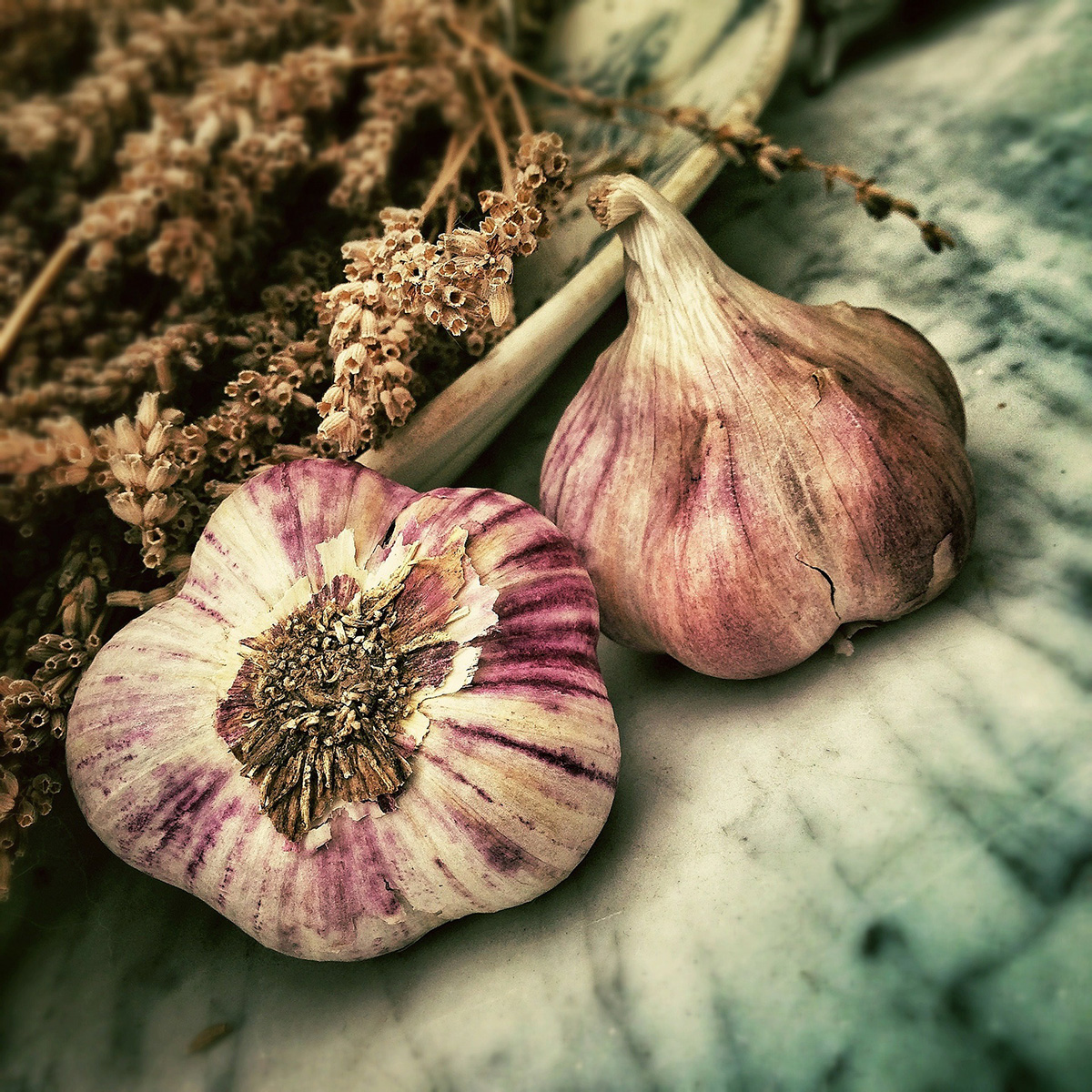
By Sarah Browning, Extension Educator, Lancaster County
Garlic produces well in Nebraska when planted in October or very-early spring, using individual bulb cloves or the small bulbils found on top-setting types. Fall or very-early spring planting is required because dormant cloves and young garlic plants must be exposed to cold temperatures of 32–50°F. for one to two months to induce bulb formation.
KINDS OF GARLIC
There are two main types of garlic — soft neck and hardneck. Don’t buy garlic bulbs at the grocery store to plant in your garden. These are mainly softneck varieties, adapted to warmer climates, and usually have not been stored at temperatures conducive to good bulb formation if they are grown in the garden.
Hardneck garlic, Allium sativum subsp. ophioscorodon, produces a woody flower stalk and also is known as “top-setting” garlic because it produces clusters of bulbils after the mostly sterile flowers bloom. Many hardneck types tend to produce large underground bulbs made up of a few large cloves and yield best when planted in the fall.
Softneck garlic, A. s. subsp. sativum, does not form a woody stalk but has flexible leaves that can be braided. Bulbs of softneck types usually have more individual cloves and yield higher than hardneck types. Softneck types also are generally better adapted to a wide range of climates. They can be spring-planted with more success than spring-planted hardneck cultivars. However, garlic connoisseurs say that softneck cultivars lack the subtle flavor differences found in hardneck cultivars.
GARLIC TYPES AND CULTIVARS
Deciding what kind of garlic to plant is a challenge since there are over 100 cultivars available from specialty suppliers!
Rocambole — hardneck. Bulbs off white with purple stripes. Clove skins brown and easy to peel. Stores about 4–5 months. Cultivars include Kilarney Red, German Red, Spanish Roja and Carpathian.
Porcelian — hardneck. Smooth white skins. Cloves more difficult to peel than Rocamboles. Stores about 5–7 months. Cultivars include German Extra Hardy, Georgian Crystal and Music.
Purple stripe — hardneck. Bulbs white with purple streaks. Clove skins brown and more difficult to peel than Rocamboles. Stores 5 to 7 months. Cultivars include Persian Star and Metechi.
Silverskins — softneck. White bulbs and clove skins. Best adapted to warm climates with mild winters. Stores for up to one year. Cultivars include Silver White, Idaho Silverskin and California Select.
Artichoke — usually a softneck, but may flower following a cold winter. Bulbs white or purple blushed. Named for their layers of overlapping cloves. Difficult to peel. Stores 6–9 months. Cultivars include Inchelium Red, Kettle River Giant and Early Red Italian.
GARDEN PREPARATION
Garlic grows best in well-drained, friable loam soils that are fertile and high in organic matter. If your soil is high in clay, add organic matter to break up clay particles for better drainage. Organic matter also will help a sandy soil hold more water. Like onions, garlic needs a steady and fairly high level of nutrients in the soil while actively growing, but they have shallow, coarse roots that are not as efficient at nutrient uptake as other crops.
When preparing the soil for planting, apply 3–4 pounds of 10-10-10 fertilizer per 100 square feet (or follow soil test recommendations) and spread one to three inches of organic matter such as chopped leaves, dry grass clippings or compost over the soil surface. Use a spading fork to mix in the organic matter. A rototiller also can be used to prepare the soil.
When incorporating organic matter that must be decayed, such as dry leaves and grass clippings, it is best to do it a few weeks before planting so soil microbes will have a chance to start breaking these materials down.
PLANTING
Just before planting, separate bulbs into individual cloves and sort by size. Do not divide the bulbs more than a few days before planting because early separation results in decreased yields. Reserve the largest cloves for planting and use the smaller cloves for cooking.
For best yields, garlic should be planted in early- to mid-October. Planting before mid-September is not recommended. Garlic cloves should begin growing and then go dormant when cold weather arrives.
For single-plant rows, plant the cloves 3–5 inches apart in an upright position (pointed end up) to ensure good emergence and straight necks. Cover cloves to a depth of about 2–3 inches. Allow 12–24 inches between rows.
Garlic also lends itself well to wide-row planting. In this planting system, space cloves five inches apart in all directions in foot-wide rows or raised beds. This requires considerably less garden space for the same yield, but weeding must be done by hand.
Water thoroughly after planting to stimulate growth. The soil must be kept evenly moist during active growth. Garlic is quite drought-sensitive, so a weekly application of one inch of water will increase yields if rainfall is lacking. Dry soil will result in irregularly shaped bulbs.
A light application of mulch (1–2 inches) after the ground freezes will help prevent frost heaving throughout the winter.
Fall-planted garlic is ready to harvest from late June to mid-July.